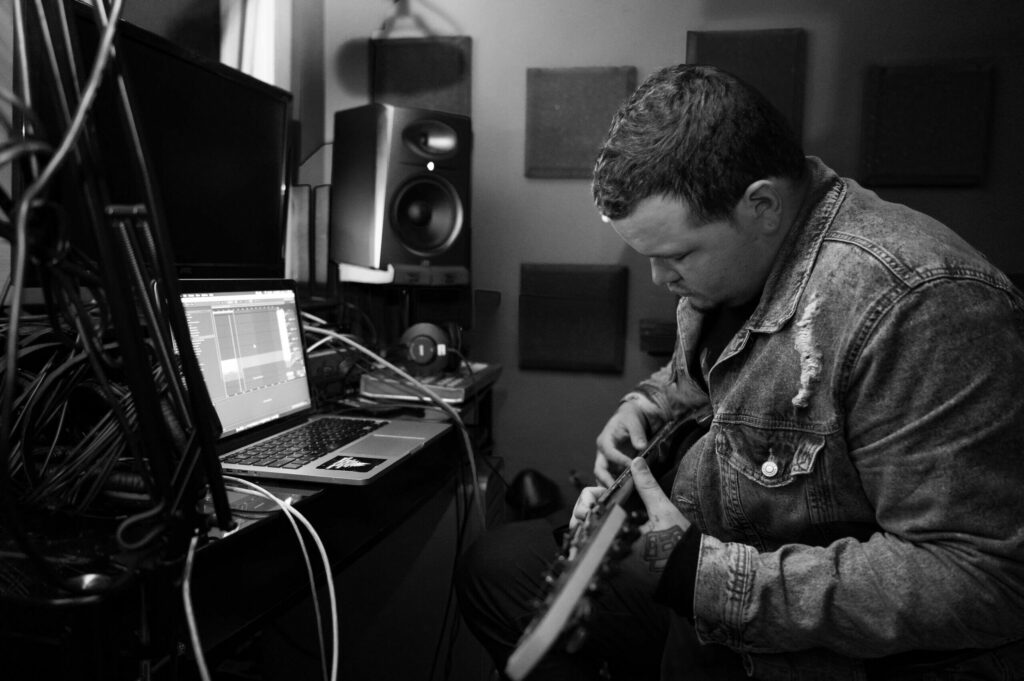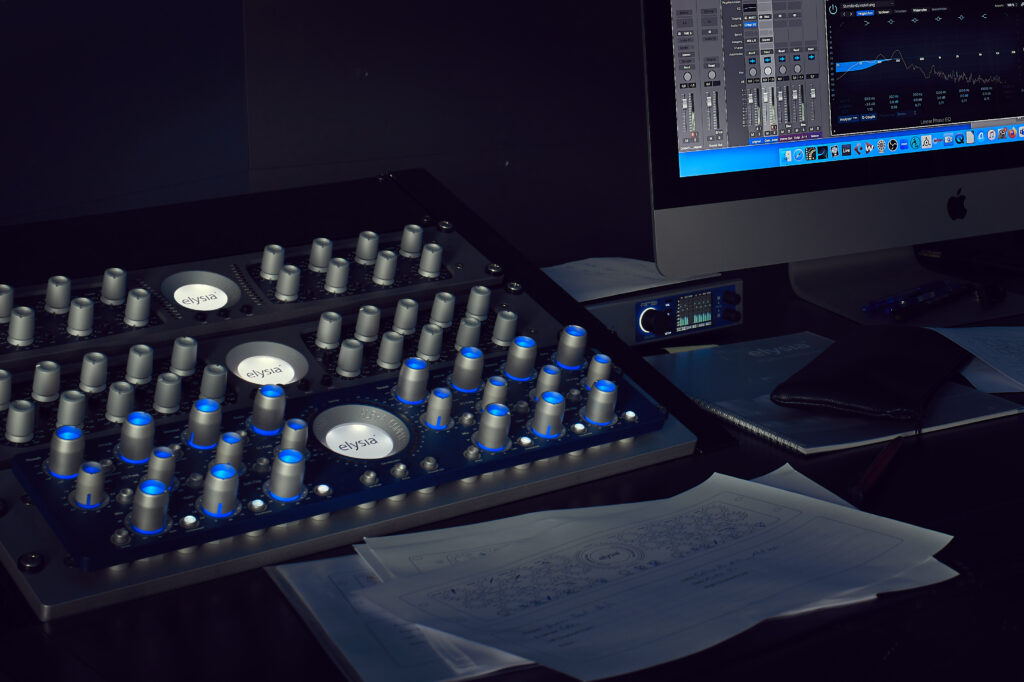Estimated reading time: 9 minutes
Core competence compression – the genesis of the elysia xpressor|neo
Question: When is good, good enough? We asked ourselves this question more than once during the relaunch of the elysia xpressor|neo. Does it even make sense to send a perfectly functioning product like the xpressor to the in-house tuning department to search for possible performance boosts? This blog article is dedicated to this topic and offers a condensed outline of the elysia company history and clarifies the question, what actually makes a first-class audio compressor?
In the beginning, there was the alpha
With a top-down approach, we started in 2006 with the alpha compressor, setting our own standards interms of quality and sound. One year later the mpressor was released and shortly after that the museq. This trio of good sounds is the foundation of our elysia product portfolio. In order to make the elysia sound accessible to less well-heeled users, we gradually introduced the 500 series modules to the market starting in 2009.
Following our own history, the first 500 module was also a compressor. The elysia xpressor 500, which despite its compact form factor carries essential components of the alpha compressor‘s DNA. A discrete VCA compressor equipped with a soft knee sidechain.
Feed-Forward
The topology is “feed-forward”, which is why negative ratios can also be implemented with the xpressor 500. Further features like a mix control, Auto Fast & Warm complete the range of functions. The xpressor 500 is without a doubt an extensively equipped signal compressor. Amazing, considering the 500 form factor. We launched this compact compressor in mid-2010 and it turned out to be a real summer hit. The first run of a hundred units was sold in a short time. Proof that our customers understood the concept. The fact that a 19″ rack version was added to the portfolio a year later was therefore a logical step. The xpressor is what can rightly be called a success story. This can be attributed to several reasons.
In any case, it is a fact that 15 years ago there were not really many good VCA compressors available on the market. The xpressor was and still is one of the anchor products that have left a lasting mark on our elyisa philosophy and the character of our products. Therefore, the wish for a contemporary, revised xpressor version had been around for quite some time. But why are compressors so important in our product portfolio and why should every musician, producer, or studio owner have a high-quality compressor in his arsenal?
Compressor anatomy
The actual task of an audio compressor is basically quite simple: Volume differences in the useful signal are to be compensated according to taste. Sounds simple, but technically it is not trivial, since the characteristics of different signal sources can vary enormously. Even with one signal family (e.g. vocals), the bandwidth is enormous.
Low tones are usually quieter and are perceived psychoacoustically with less emphasis than medium and high-pitched vocals. In addition, almost all natural sound sources contain volume modulations that cause more overtones (partial oscillations) to be generated at higher levels.
If you try to embed such natural, highly dynamic signals into a comparatively static mix, you can hardly avoid additional dynamics processing. The tool of choice is a compressor.
How would an xpressor, for example, perform this processing? The decisive control element, in this case, would be a VCA (voltage-controlled amplifier), which can change the volume of the useful signal in a voltage-controlled manner. Thus, the quality of the VCA has decisive importance on the control process and ultimately on the sound quality.
For a better view
For a simpler explanation, a comparison can be made with optics. If you want to look into the distance, you need binoculars. The better the mechanics and the quality of the glass, the sharper you can see the object in the eyepiece. In this context, an interesting analogy can also be made between analog and digital. A high-quality digital camera has an optical zoom to magnify distant objects and make them as sharp as possible. A smartphone, on the other hand, is often only equipped with digital zoom. The more you work with digital zoom, the coarser the image becomes.
This inevitably leads to a loss of quality. The situation is similar with a compressor. If you want to compensate for large differences in level, you have to make up for the compressed compressor signal after processing with the help of the make-up gain, i.e. you have to re-amplify it. The quality of this catch-up process is essential for sound quality. Do all the subtleties come to the front, are the quiet parts in the signal adequately amplified without bringing unwanted artifacts to the fore?
Is your compressor able to present all the subtleties of quiet parts of the signal in a striking way in the case of large-level jumps after processing? Digital compressors in particular are often at a disadvantage in this process, because the make-up gain is often applied to the digital domain and therefore has to contend with similar resolution problems as a digital camera zoom.
Evolution
With the xpressor, the redesign of the neo version already has a very well-positioned basis. The tuning of attack, threshold, release, and ratio on the one hand, and the numerous additional features like auto-fast, log-release, warm, and parallel compression on the other hand basically cannot be improved any further. Therefore, every user of a classic xpressor will immediately feel comfortable with the workflow and the way the xpressor|neo works.
As developers, we nevertheless asked ourselves, where is there still sound capital to be gained? What can be done to display even more subtleties in the sound? What other adjustments can be made? This is not a trivial task, especially since some sound phenomena simply defy evaluation by audio measurements.
For example, improved three-dimensionality in terms of stereo base width can only be determined in complex listening tests. The fact is: There are definitely starting points and options to improve the sound. However, you have to be able to think “outside the box” and look in the right places. The classic xpressor has been available since 2010. Since then, the world has moved on. So our expertise has evolved, as has the fact that modern components and assemblies open up new (sound) possibilities.
New research and development approach learned

Ideas and improvements sometimes come from unusual disciplines. At elysia, we always take an interdisciplinary approach, which is why the redesign of the xpressor uses a process whose origins lie in circuit board design and, at first glance, doesn’t have much to do with audio processing.
Originally, it was an attempt to optimize the ground concepts and voltage supply of critical components such as FPGAs, microcontrollers, and DSPs. We applied this method to the design of audio circuits on a test basis and were surprised to find that audio circuits can be supplied with current peaks and corresponding voltages much faster as a result. The result is a significant jump in signal quality. In parallel, we are always on the lookout for improved components. Especially for components that were not yet available in 2010, as these carry the supposed potential for a performance increase.
Especially due to the requirements of modern DSPs and switching power supplies, some new electrolytic capacitors have been developed in the last few years. These special electrolytic capacitors have smaller values concerning their parallel and serial resistance. We have tested these components, among others, as coupling electrolytic capacitors or as buffering for the power supply, with partly astonishing results.
Especially when you consider that these electrolytic capacitors were not originally designed for use in audio circuits. This is how you can reach your goal even via supposed detours. Due to these “extra miles” the xpressor|neo has an improved impulse behavior and a more precise transient reproduction, which can also be proven by measurements.
Encore

But that’s not all. We have given the input circuit an additional filter in the form of a small coil, which provides a special RF suppression that has a positive effect on the overall sound. Throughout the circuit design, there is a reference voltage that drives the discrete circuits. This has been completely redesigned and is now more resilient to disturbances at the voltage supply level. As an aside, this is a thorny ongoing issue with the 500 modules.
We cannot say which 500 Rack our customers use for their modules. Depending on the manufacturer and model, the voltage supply of these 500 Racks is sometimes more or less good. Often you search in vain for concrete information about the interference voltage distances and other relevant values.
The xpressor|neo, on the other hand, is particularly well positioned in terms of power supply. The VCAs are another important point for increasing performance. In the xpressor|neo, we have reworked the control of the VCAs, resulting in improved stereo separation. In addition, the VCAs in the neo are driven completely symmetrically, which audibly benefits the stereo image. We were able to further improve the impulse response by revising the output amplifiers, which we have given new output filters.
More is more

In addition to the pure compressor circuit, the xpressor|neo has improvements in the additional functions. For example, the sidechain is more finely structured to allow the suppression of artifacts at the level of the voltage supply. A 2-layer board has now become a 4-layer board with a large mass area. This is important to minimize external interference.
It also provides a low-impedance connection between the power supply and the audio circuits, which can then be supplied with power more quickly. The sum of these improvements makes a clearly audible difference. The classic xpressor is an audiophile tool on a high level, but the xpressor|neo is in direct comparison sonically a step ahead. Especially the transient reproduction sets new standards, the stereo image is more three-dimensional and the overall sound simply shows more spatial depth. The bass range is extended, and the mids resolve more finely – the sound quality is outstanding for this price range and we do not say that without pride.
Compression expertise in a new look
The xpressor|neo is not only a clear power-up in terms of sound. The neo has also improved its appearance. We have beveled the edges of the housing, and the focus is now confidently placed on the center, where the company logo and the device name take their VIP place. This makes the renaissance of the xpressor|neo a rounded affair visually as well. In retrospect, we didn’t realize how much work the new edition of the neo would require.
Especially since it was not clear whether and to what extent the basic version of the xpressor could be further optimized. However, we are more than satisfied with the results and it is still amazing what potential for improvement can be achieved with new design methods and improved components. Even users who already have an original xpressor in their inventory should definitely try out the xpressor|neo. Especially in critical applications such as bus processing or mastering applications, you will be rewarded with a new sound quality that undoubtedly justifies an upgrade.




